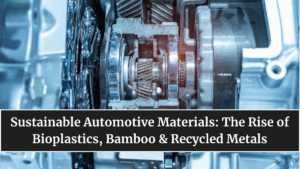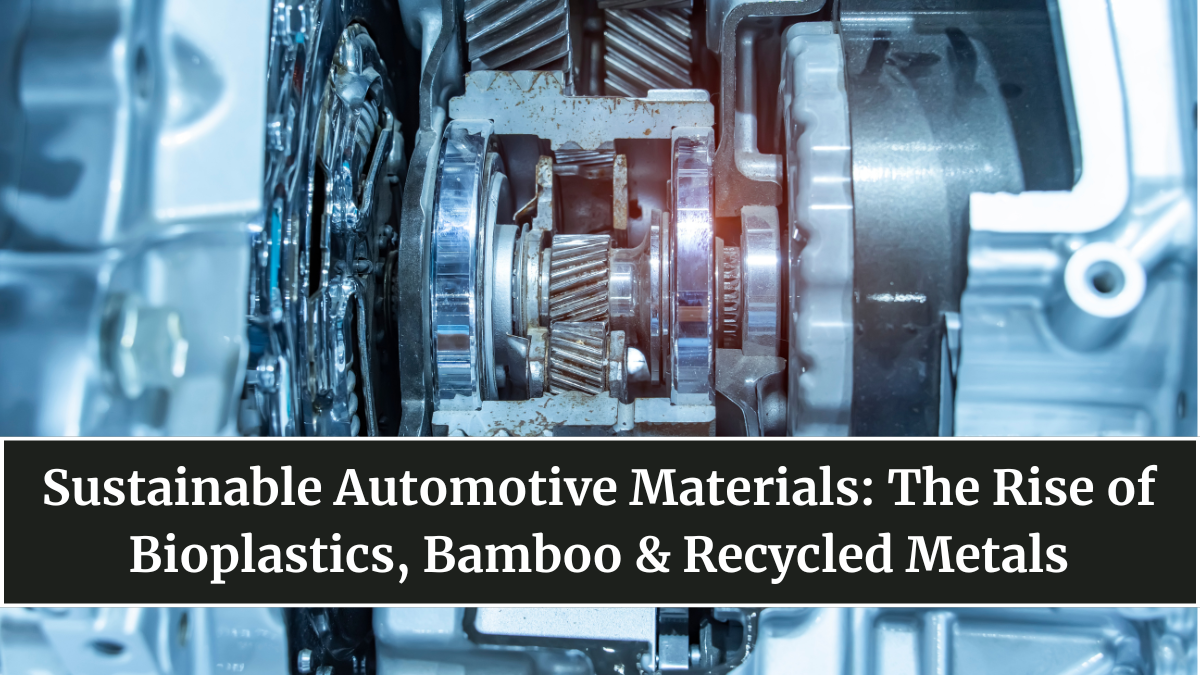The automotive industry is undergoing a green revolution — and it’s not just about electric engines. In 2025, sustainable automotive materials are at the forefront of innovation, reshaping how vehicles are designed, built, and recycled. From bioplastics made of plants to bamboo interiors and recycled aluminum frames, automakers are proving that performance and sustainability can go hand in hand.
As governments tighten emission norms and consumers demand eco-friendly products, leading brands are rethinking every material that goes into a car. The goal? Build vehicles that are lighter, cleaner, and fully recyclable, without compromising comfort or safety.

The Shift Toward Eco-Friendly Vehicle Design
The average car today contains thousands of components — and traditionally, many were derived from petroleum-based plastics and mined metals. But as sustainability becomes central to design, automakers are moving toward circular production models, where materials are reused and waste is minimized.
In 2025, the focus is on three major material innovations:
-
Bioplastics: Made from renewable sources like corn, sugarcane, and algae.
-
Natural Fibers: Bamboo, jute, and flax for panels and interiors.
-
Recycled Metals: Aluminum, magnesium, and steel recovered from end-of-life vehicles.
Together, these eco-friendly materials are reducing both vehicle weight and carbon footprint, paving the way for sustainable mobility.
Bioplastics: Redefining Car Interiors
Bioplastics are among the most transformative materials in automotive design. Unlike traditional plastics derived from crude oil, bioplastics are produced from organic sources such as corn starch, sugar beet, or cellulose.
Advantages include:
-
Up to 80% lower CO₂ emissions during production.
-
Full biodegradability in controlled environments.
-
Comparable strength and durability to petroleum plastics.
Major carmakers like Toyota, Ford, and BMW are integrating bioplastics in dashboards, door trims, and seat fabrics. The result: interiors that look premium but leave a smaller environmental footprint.
Bamboo and Natural Fibers: Nature Meets Design
Bamboo, known for its strength and rapid growth, has become a favorite for sustainable car interiors. Its natural texture and durability make it ideal for decorative panels, flooring, and seat frames.
Meanwhile, natural fibers like jute and flax are replacing synthetic composites in door panels and roof liners. These materials are lightweight, cost-effective, and biodegradable, reducing both manufacturing emissions and end-of-life waste.
In luxury cars, automakers are experimenting with woven bamboo trims and hemp-based composites, offering both sustainability and sophisticated aesthetics.
Recycled Metals: Closing the Loop in Auto Manufacturing
Metal recycling is one of the strongest pillars of sustainable automotive production. In 2025, over 40% of all aluminum used in vehicles comes from recycled sources.
Why recycled metals matter:
-
Reusing aluminum saves up to 95% of the energy required for new production.
-
Steel recycling significantly cuts carbon emissions and mining waste.
-
It supports a closed-loop manufacturing process, where old cars become the raw material for new ones.
Companies like Tesla, Volvo, and Audi have established in-house recycling facilities, ensuring minimal waste and maximum reuse. Even high-strength components like engine blocks and wheel hubs are now forged from recycled metal alloys without compromising safety.
Benefits Beyond the Environment
Switching to sustainable materials offers several advantages beyond reducing emissions:
-
Lighter vehicles translate to better mileage and battery efficiency.
-
Cost savings from lower energy consumption in production.
-
Healthier cabin air with fewer volatile organic compounds (VOCs).
-
Improved brand value, as eco-conscious consumers increasingly choose green mobility.
For EVs in particular, lighter materials extend driving range and reduce charging needs, directly contributing to better energy efficiency.
Challenges in Scaling Sustainable Materials
Despite the progress, mass adoption faces a few hurdles:
-
Cost: Bioplastics and natural fibers are still pricier than traditional materials.
-
Durability Testing: Long-term performance under extreme temperatures remains under study.
-
Supply Chain Constraints: Limited access to sustainable raw materials can slow production.
-
Recycling Infrastructure: Not all countries have advanced recycling systems for mixed composites.
Automakers are addressing these challenges through research partnerships with material scientists and startups developing scalable, affordable alternatives.
The Future: Circular Cars and Carbon-Neutral Manufacturing
By 2030, the goal is clear — cars that can be fully recycled or repurposed at the end of their life. Automakers are developing modular vehicle designs where parts can be easily replaced, reused, or melted down for new production.
Emerging trends shaping this future include:
-
Bio-composite panels that are both strong and compostable.
-
AI-driven material tracking for efficient recycling management.
-
Zero-waste factories using renewable energy sources.
The next generation of vehicles won’t just drive sustainably — they’ll be sustainable, inside and out.
FAQs
What are sustainable automotive materials?
They are eco-friendly alternatives like bioplastics, natural fibers, and recycled metals used to reduce the environmental impact of car manufacturing.
Why is bamboo used in car interiors?
Bamboo is strong, lightweight, and renewable, making it ideal for sustainable panels, trims, and flooring.
How do bioplastics benefit the environment?
Bioplastics emit less carbon during production and are biodegradable, reducing plastic waste and dependency on fossil fuels.
Are recycled metals as durable as new ones?
Yes. Recycled metals retain their strength and properties, making them ideal for structural components.
Will all cars use sustainable materials in the future?
By the 2030s, most automakers aim to use majority eco-friendly materials, supported by circular production and recycling systems.
Click here to know more.
